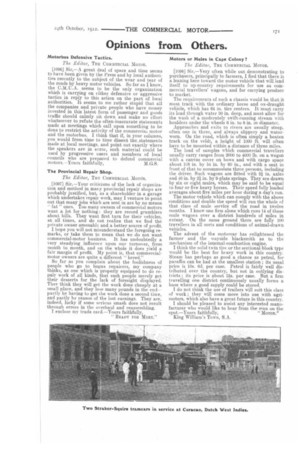Opinions from Others.
Page 17

If you've noticed an error in this article please click here to report it so we can fix it.
Motorbus Defensive Tactics.
The Editor, THE COAIMERCIAL MOTOR.
11096] Sir,—A great deal of space and time seems to have been given by the Press and by local authorities recently to the subject of the wear and tear of the roads by heavy motor vehicles. So far as I know, the C.M. U.A. seems to be the only organization which is carrying on either defensive or aggressive tactics in reply to this action on the part of local authorities. It, seems to me rather stupid that all the companies and private people who have money invested in this latest form of passenger and goods traffic should calmly sit down and make no effort whatsoever to refute the often-inaccurate statements made at meetings which call upon something to be done to restrict the activity of the commerciat motor and the motorbus. I think that if, in your columns, you would from time to time dissect the.statements made at local meetings, and point out exactly where the speakers are in error, such material could be used by progressive users and members of local councils who are prepared to defend commercial motors.—Yours faithfully, M.G.S.
The Provincial Repair Shop.
The Editor, TH E COMMERCIAL MOTOR.
[10971 Sir,—Your criticisms of the lack of organization and method in many provincial repair shops are probably justified, but, as a shareholder in a garage which undertakes repair work, may I venture to point out that many jobs which are sent in are by no means fat" ones. Too many owners of commercial motors want a lot for nothing : they are record grumblers about bills. They want first turn for their vehicles, at all times, and do not realize that we find the private owner amenable and a better source of profit. I hope you will not misunderstand the foregoing remarks, or take them to mean that we do not want commercial-motor business. It has undoubtedly a very steadying influence unon our turnover, from month to month, and on the whole it does yield a fair margin of profit. My point, is, that commercialmotor owners are quite a different "breed." So far as you complain about the foolishness of people who go to bogus repairers, my company thinks, as one which is properly equipped to do repair work of all kinds, that such people merely get their desserts for the lack of foresight displayed. They think they will get the work done cheaply at a small place, and they lose many pounds in the end-partly by having to get the work done a second time, and partly by reason of the lost earnings. They are, indeed, lucky if some serious smash does not result through errors in the overhaul and reassembling. I enclose my trade card.—Yours faithfully, "READY FOR MORE." Motors or Mules in Cape Colony ?
The Editor, THE COMMERCIAL MOTOR.
[1098] Sir,—Very often while out demonstrating to purchasers, principally to farmers, I find that there is a leaning here toward the motor vehicle that will lend itself to up-country requirements for use as commercial travellers' wagons, and for carrying produce to market.
The requirements of such a chassis would be that it must track with the ordinary horse and ox-draught vehicle, which has 64 in. tire centres. It must carry its load through water 30 in. deep, and must allow for the wash of a moderately swift-running stream with boulders under the wheels 6 in. to 8 in. in diameter.
Approaches and exits to rivers are usually steep, often one in three, and always slippery and waterworn. On the road, which is often simply a beaten track on the veldt, a height of 1000 ft. will often have to be mounted within a distance of three miles.
The load of samples which commercial travellers usually carry ranges from 2000 to 4000 lb. on a wagon with a canvas cover on bows and with cargo apace about 108 in. by 54 in. by 60 in., and with a seat in front of that to accommodate three persons, including the driver. Such wagons are fitted with 21 in. axles and 40 in. by 2i in. by 9-plate springs. They are drawn by six or eight mules, which may be said to be equal to four or five heavy horses. Their speed fully loaded averages about five miles per hour during a day's run. The motor vehicle which can comply with the above conditions and double the speed will run the whole of that class of mule service off the road in twelve months. I know one firm alone which runs 14 of these mule wagons over a district hundreds of miles in extent. On the same ground there are fully 100 travellers in all sorts and conditions of animal-drawn vehicles.
The advent of the motorcar has enlightened the farmer and the wayside blacksmith as to the mechanism of the internal-combustion engine.
I think the solid twin tire or the sectional-block type would be the best for heavy work in this country. Steam has perhaps as good a chance as petrol, for paraffin can be had at the smallest station ; its usual price is 10s. 6d. per case. Petrol is fairly well distributed over the country, but not in outlying districts ; its price is about 15s. per case. But a firm travelling one district continuously usually forms a base where a good supply could be stored. I do not think the use of trailers will suit this class of work ; they will come more into use with agrimotors, which also have a great future in this country.
I should be pleased to assist any interested manufacturer who would like to hear from the man on the spot. —Yours faithfully, "MOTOR." King William's Town, S.A.






















